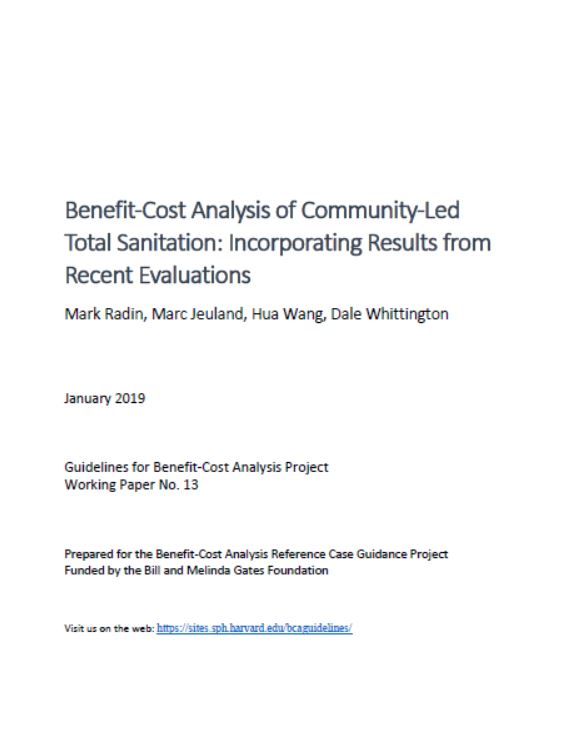Benefit‐Cost Analysis of Community‐Led Total Sanitation: Incorporating Results from Recent Evaluations
 |
rapport Jan 2019 ; 58 pages
Aut. Marc Jeuland & Mark Radin & Hua Wang & Dale Whittington
Ed. Harvard T.H. Chan School of Public Health - Boston
Téléchargeable sous format: PdF
Téléchargeable chez l'éditeur
Page de présentation d'un éditeur
Abstract:
This document was prepared for the Benefit‐Cost Analysis Reference Case Guidance Project; Funded by the Bill and Melinda Gates Foundation, January 2019. See: https://sites.sph.harvard.edu/bcaguidelines/
Abstract:
We analyze the costs and benefits of “Community-Led Total Sanitation” (CLTS), a sanitation intervention that relies on community-level behavioral change, in a hypothetical rural region in Sub-Saharan Africa with 200 villages and 100,000 people.
The analysis incorporates data on the effectiveness of CLTS from recent randomized control trials (RCTs) and other evaluations. We value reduced mortality benefits by adjusting estimates for the value of statistical life (VSL) from high income countries to reflect incomes in Sub-Saharan Africa.
Reduced morbidity benefits are calculated using a cost of illness (COI) approach based on recent studies quantifying the cost of diarrheal disease in Sub-Saharan Africa. Time savings from owning a latrine are valued using estimates for the shadow value of time based on a proportion of the average local wage. Costs include the cost of intervention implementation and management, households’ time costs for participating in the community behavioral change activities, and the cost of constructing latrines.
We estimate the net benefits of this intervention both with and without the inclusion of a positive health externality, which is the additional reduction in diarrhea for an individual when a sufficient proportion of other individuals in the community construct and use latrines and thereby decrease the overall load of waterborne pathogens and fecal bacteria in the environment.
We examine the sensitivity of the results to changes in the effectiveness of the CLTS intervention. A probabilistic sensitivity analysis using Monte Carlo simulation is used to examine the sensitivity of the results to changes in all of the parameters in the benefit-cost model.
We find that CLTS interventions would pass a benefit-cost test in many situations, but that benefit-cost metrics are not as favorable as many previous studies suggest. The model results are sensitive to baseline conditions, including the income level used to calculate the VSL, the discount rate, and the time spent traveling to defecation sites.
We conclude that many communities will have economic investment opportunities that are more attractive than CLTS, and recommend careful economic analysis of CLTS in specific locations.
Mots clefs: |
ATPC Assainissement Total Piloté par la Communauté (CI) (DT) (OP) (ope) , économies (CI) (DT) (OP) (ope) , évaluation, impacts (CI) (DT) (OP) (ope) |
Editeur/Diffuseur: |
|
Harvard T.H. Chan School of Public Health - Boston - Etats Unis |
En cas de lien brisé, nous le mentionner à communication@pseau.org